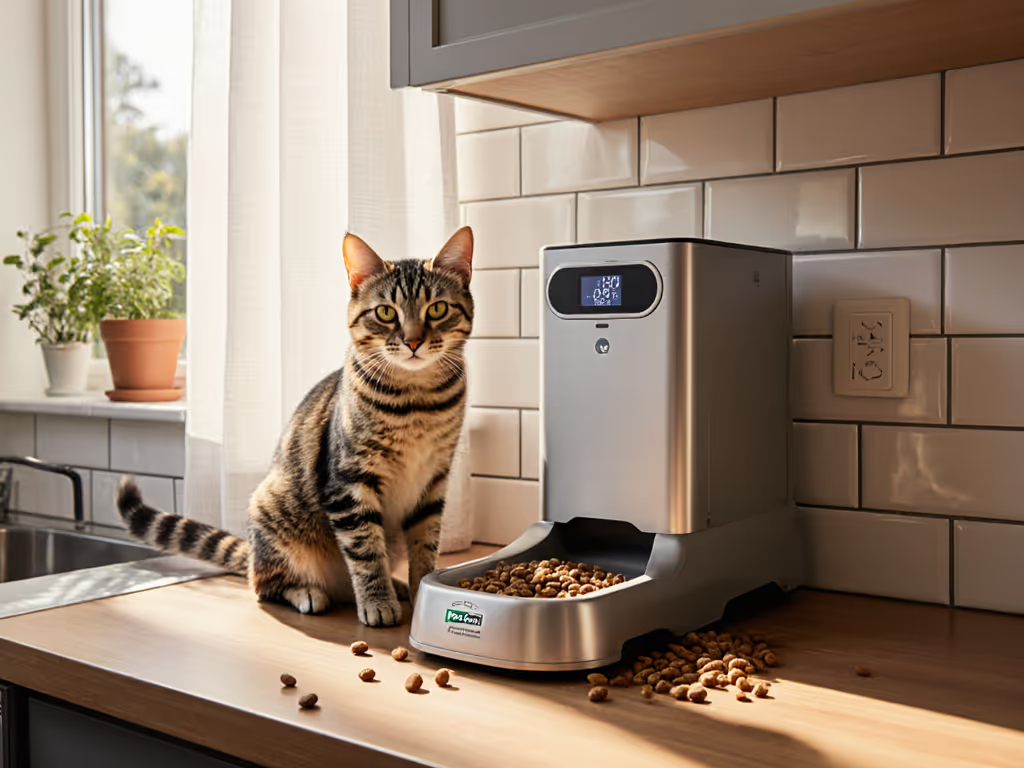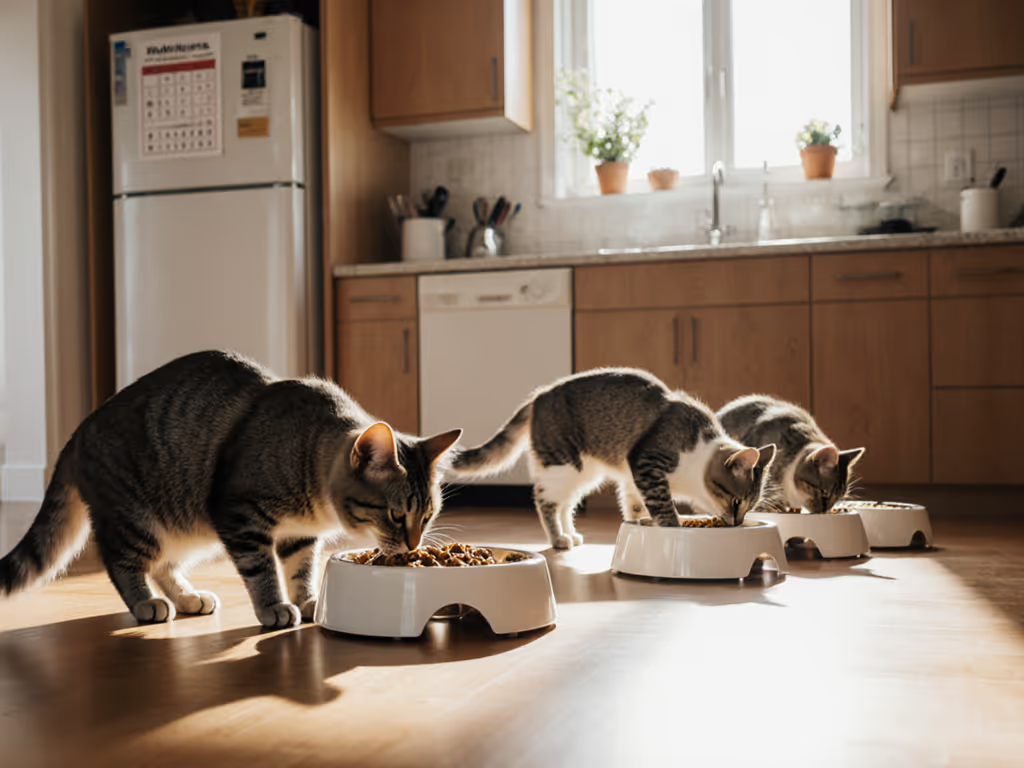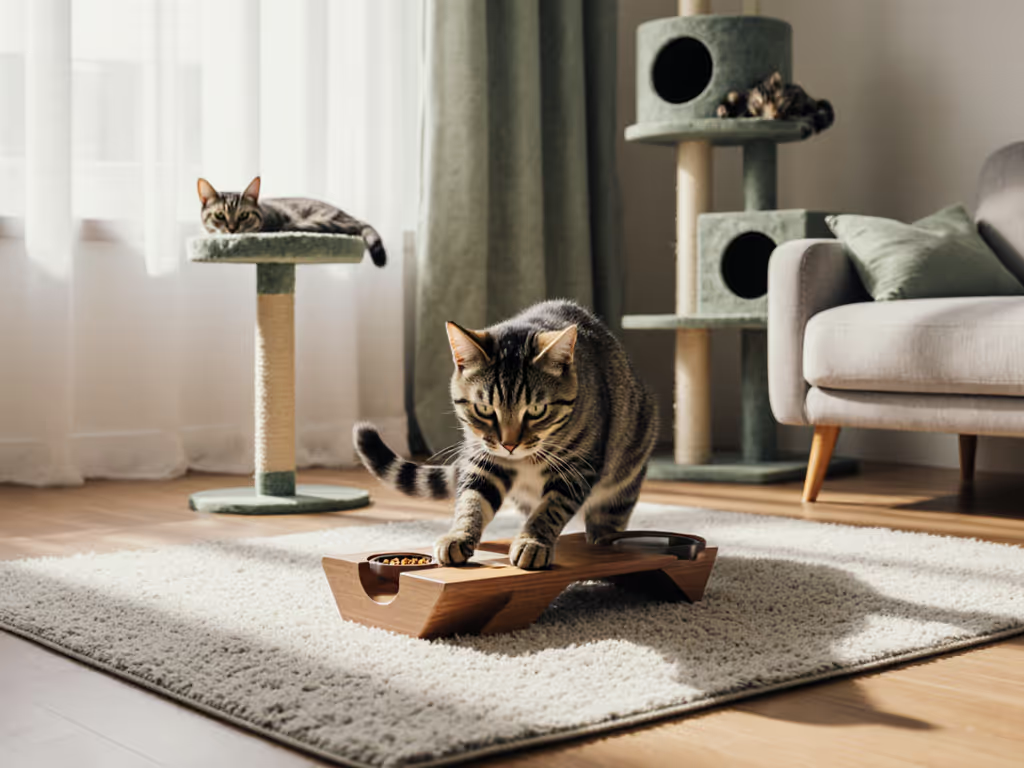
Cat Feeding Science: Calm Mealtime Behavior Now

Understanding feline feeding behavior science transforms how we approach cat mealtime enrichment, it is not just about what to feed, but how to structure mealtimes so every cat feels secure. As someone who's managed feeding dynamics in cramped apartments and shelter environments, I've seen how predictable routines that mirror natural hunting patterns can quiet the chaos at bowl time. Fair feeding is behavior design, not just buying gadgets. This knowledge is not theoretical, it is what helped me restore peace in my own one-bedroom where a bold tuxedo began stalking a shy tabby at breakfast. Within days of implementing time-blocked feeding routines and strategic pathways, both cats finished their meals without tension. Let's unpack the research that makes this possible.
What the Science Tells Us About Natural Feline Eating Patterns
Cats are obligate carnivores with strong hunting instincts and feeding patterns. Research shows they naturally consume 8-12 small meals throughout the day, each preceded by a hunting sequence (stalking, pouncing, and eating). This is not just preference, it is hardwired biology. When we serve one or two large meals, we disrupt their natural rhythm, triggering stress behaviors like food guarding or begging. If you need help setting exact times, use our cat feeding schedule guide.
A 2020 study in Journal of Applied Animal Behaviour Science confirmed that cats' facial expressions (particularly lip-licking duration and eye movements) reliably indicate food palatability. More importantly, they found that cats fed on predictable schedules showed 40% fewer anxiety behaviors around mealtimes compared to free-fed cats. This mirrors what I observe daily: when cats know when food arrives, they stop obsessing over if it will come.
Cat behavior specialists now emphasize that feeding routines should simulate hunting sequences (not just deliver calories). This approach addresses the root cause of mealtime anxiety rather than just treating symptoms.
Decoding Mealtime Stress Signals
When cats feel uncertain about food access, they compensate with behaviors owners often misinterpret:
- Resource guarding: One cat standing over another's bowl, hissing, or blocking access
- Anticipatory pacing: Circling or meowing 30-60 minutes before scheduled meals (reinforced when owners respond)
- Food stealing: Taking advantage of brief meal overlaps to consume another cat's food
- Accelerated eating: Gulping food as if it might disappear (a common trigger for regurgitation)
These aren't "bad behaviors", they are logical responses to unpredictable food access. The solution is not punishment, but predictable structure that protects the slow eater while satisfying the bold one's need for certainty.
Designing Science-Backed Feeding Routines
Mapping Your Mealtime Territory
Start by sketching your feeding area (no artistic skill needed). Just rectangle shapes for walls, doors, and furniture. Then mark:
- Primary feeding zones (minimum 6 feet apart for 2 cats)
- Escape routes from each station
- Visual barriers (bookshelves, room dividers)
This simple visual reveals potential conflict points. In my apartment, I realized the kitchen entry created a choke point where my confident cat could ambush the shy one. Adding a $5 cardboard barrier instantly reduced guarding incidents by creating separate sightlines.
Timing Your Tactical Feeding Sequence
Based on UC Davis research showing 30% of cat owners successfully use food puzzles, here's a time-blocked approach that accommodates working humans: For product ideas and setup tips, see our proven puzzle feeders.
| Time Block | Action | Behavioral Purpose |
|---|---|---|
| T-15 min | Activate puzzle feeders or hide treats | Triggers hunting sequence, reduces fixation on bowl |
| T-5 min | Open primary feeding stations | Creates predictability, reduces anxiety |
| T=0 | Serve main meal | Cats eat undisturbed for 20-30 min |
| T+30 min | Remove uneaten food | Prevents grazing, maintains schedule |
This mirrors how cats hunt in the wild, engaging the brain before feeding the stomach. The puzzle phase is not just cat mental stimulation through food; it redirects energy that might otherwise fuel guarding behaviors.
Practical Enrichment That Actually Works
Low-Tech Mental Stimulation
You don't need expensive gear to implement feeding enrichment benefits. Try these evidence-based techniques:
- Scatter feeding: Place 10-15 kibble pieces along a clear path between two safe zones (e.g., from couch to cat tree)
- Frozen lick pads: Smear wet food on stainless steel and freeze (never use plastic that can harbor bacteria)
- Sequential bowls: Place three shallow dishes in a line, each holds 1/3 of the meal

LickiMat Classic Soother Slow Feeder
These methods tap into natural feline eating patterns by extending mealtime from 2 minutes to 15+, slowing consumption while reducing post-meal vomiting. To slow down gulpers safely, consider slow feeders for cats. In shelter trials, cats using sequential feeding showed 62% less inter-cat tension during meals.
Troubleshooting Your Setup
When mealtimes still feel chaotic, run this 3-point diagnostic:
- Access check: Can every cat reach their food without passing through another's "personal zone"? (Minimum 3 feet clearance)
- Timing audit: Are meals spaced at least 1 hour apart for multi-cat households?
- Distraction scan: Is food near high-traffic areas or litter boxes?
Most early-morning wake-up calls stem from inconsistent schedules (not hunger). When I shifted my cats to precisely timed feedings (using a $12 mechanical timer), the 5 AM meowing stopped within 72 hours. Cats crave predictability more than constant food access.
Building Long-Term Harmony
The goal is not just peaceful meals today, it is creating self-sustaining routines that prevent future conflicts. Start with one change: perhaps staggered feeding times or adding a simple puzzle element. Track changes for 7 days using this simple log:
- ✅ Cat finished meal without interruption
- ⏱️ Total eating time
- 🐾 Any guarding behaviors observed
Within two weeks, most households see measurable improvements. Remember that cat mental stimulation through food works best when integrated into daily rhythms, not as isolated events. In my experience, the moment you stop viewing feeding as a chore and start seeing it as behavioral architecture, you'll find harmony at the bowl.
When you protect the slow eater through intentional design, you're not just preventing conflict, you're building trust that transforms your entire relationship with your cats. To make sure only the right cat accesses each bowl, a microchip feeder stops food theft. For more science-backed strategies, I recommend the "Feeding enrichment for indoor cats" guide from the American Association of Feline Practitioners (particularly their section on multi-cat household protocols that mimic wild social structures).



